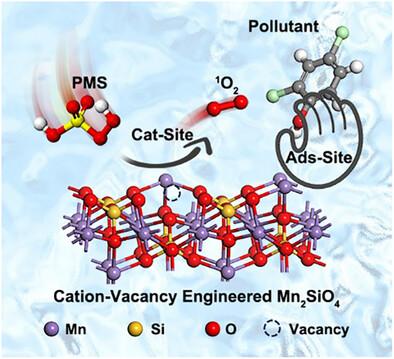Enhancing Reactive Oxygen Species Generation and Pollutant Adsorption in Advanced Oxidation Processes with Cation Vacancy-Driven Dual-Site Mn2SiO4 Catalysts
IF 26.8
1区 材料科学
Q1 CHEMISTRY, MULTIDISCIPLINARY
引用次数: 0
Abstract
Catalytic advanced oxidation processes (AOPs) have emerged as a promising strategy for the near-complete mineralization of all-organic pollutants via the strong oxidizing power of reactive oxygen species (ROS). However, practical implementation is hindered by the low ROS generation yield owing to insufficient catalytically active sites and ineffective utilization stemming from transient radical lifetimes. Herein, cation vacancy-engineered manganese silicate (V-Mn2SiO4) catalysts comprising dual reaction sites are presented, which enable the highly efficient oxidation of recalcitrant organic pollutants through the activation of peroxymonosulfate. Experimental results and density functional theory calculations confirm that Mn sites adjacent to vacancies serve as the primary active centers for peroxymonosulfate activation, whereas adjacent O sites facilitate pollutant adsorption. This dual-site configuration effectively lowers the activation energy barrier and enhances peroxymonosulfate activation and singlet oxygen (1O2) generation while optimizing the 1O2 migration distance via pollutant adsorption and enrichment. The rate constants of V-Mn2SiO4 against rhodamine B and 2,4-dichlorophenol pollutants are 1.171 and 0.1291 min−1, respectively, which are comparable to those reported for atomically dispersed metal nanocatalysts in AOPs. This discovery marks a breakthrough in AOPs, accelerating their practical application in environmental remediation and advancing sustainable pollution control technologies.

阳离子空位驱动的双址Mn2SiO4催化剂促进深度氧化过程中活性氧生成和污染物吸附
催化深度氧化法(AOPs)利用活性氧(ROS)的强氧化能力,已成为一种很有前途的近完全矿化全有机污染物的方法。然而,由于催化活性位点不足和瞬态自由基寿命导致的无效利用,导致ROS生成率低,阻碍了实际实施。本文提出了含有双反应位点的阳离子空位工程硅酸锰(V-Mn2SiO4)催化剂,该催化剂通过过氧单硫酸盐的活化,实现了对难降解有机污染物的高效氧化。实验结果和密度泛函理论计算证实,空位附近的Mn位点是过氧单硫酸盐活化的主要活性中心,而邻近的O位点则有利于污染物的吸附。这种双位点结构有效地降低了活化能垒,增强了过氧单硫酸盐活化和单线态氧(1O2)的生成,同时优化了1O2通过污染物吸附和富集的迁移距离。V-Mn2SiO4对罗丹明B和2,4-二氯酚污染物的反应速率常数分别为1.171和0.1291 min−1,与AOPs中原子分散金属纳米催化剂的反应速率相当。这一发现标志着AOPs的突破,加快了AOPs在环境修复中的实际应用,推动了可持续污染控制技术的发展。
本文章由计算机程序翻译,如有差异,请以英文原文为准。
求助全文
约1分钟内获得全文
求助全文
来源期刊

Advanced Materials
工程技术-材料科学:综合
CiteScore
43.00
自引率
4.10%
发文量
2182
审稿时长
2 months
期刊介绍:
Advanced Materials, one of the world's most prestigious journals and the foundation of the Advanced portfolio, is the home of choice for best-in-class materials science for more than 30 years. Following this fast-growing and interdisciplinary field, we are considering and publishing the most important discoveries on any and all materials from materials scientists, chemists, physicists, engineers as well as health and life scientists and bringing you the latest results and trends in modern materials-related research every week.
 求助内容:
求助内容: 应助结果提醒方式:
应助结果提醒方式:


